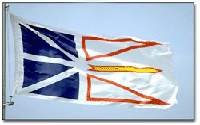|
Newfoundland And Labrador
Newfoundland and Labrador is the most Easterly Province of Canada. There are two portions to the Province, the Island of Newfoundland is located in the Gulf of St. Lawrence and Labrador is on the Eastern part of the Canadian mainland. They are seperated by the Strait of Belle Isle. The only joining neighbour is the Province of Quebec to the West as the East of the Province is on the ocean. The Island of Newfoundland is 111,390 square kilometers and Labrador is 294,330 square kilometers making the total area of the Province 405,720 square kilometers. It is more than three times the size of the Maritime Provinces. Newfoundland has it's own time zone called the Newfoundland Time Zone which is Greenwich Mean Time -3.5 hours. Between the months of April and October Daylight Saving is in effect and the difference is GMT -2.5 hours. Labrador is in the Atlantic Time Zone which is Greenwich Mean Time -4 hours, it also observes Daylight Savings between the months of April and October when the difference is GMT -3 hours. Newfoundland and Labrador has a total population of 512,930 (2001), of which 27,864 (2001) live on the mainland portion of Labrador and 485,066 (2001) live on the island of Newfoundland. The Avalon Peninsular, located at the South end of the Island, is the most populated area of Newfoundland and home to the Provincial capital, St John's. The other principal cities of the Province are Mount Pearl and Gander all located on Newfoundland Island and Happy Valley-Goose Bay is in Labrador on the mainland. The Province is also dotted with many towns and fishing villages. The coastline is very rugged and consists of coves, fjords and offshore islands. The interior is mostly covered with forest and barren rock; 31,340 square kilometers are covered by inland water. These geographical characteristics give the Province some great recreational opportunities in the wilderness with some amazing
Parks And Ecological Sites.
St. John's is said to be the foggiest, wettest, snowiest and windiest of all the major cities in Canada. The locals apparently call it character-building! The average July temperatures in Newfoundland are 13 to 16 degrees Celsius, with the interior normally warmer than to coast. The January average temperature is -4 degrees although it could fall to -34 degrees Celsius. Heavy snowfall is common and annual precipitation averages about 44inches. Labrador tends to be cooler with average July temperatures between 10 and 13 degrees Celsius and January about -18 degrees Celsius, it can be as cold as -51 degrees Celsius in Western Labrador. The annual precipitation varies from about 40 inches in the south east to 20 inches in the extreme north. The Provincial Government of Newfoundland and Labrador is led by the Honourable Kathy Dunderdale who, after taking over from Danny Willaims, is the leader of the Progressive Conservative Party. The Province is responsible for administering the Healthcare System which provides a basic care system for the Newfoundland and Labrador residents. The Education System and the Driving Regulations are also regulated by the Province and have differences from other parts of Canada. Newfoundland and Labrador has a Harmonized Sales Tax (HST) of 15 per cent. This is composed of both the Federal GST 5% and the Provincial sales tax 8% and is applied to the retail sale or rental of most goods and certain services in the Province. Residents of Newfoundland and Labrador are subject to
Provincial and Federal Taxation.
|




